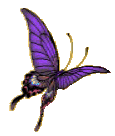
|  |  |

|  |  |
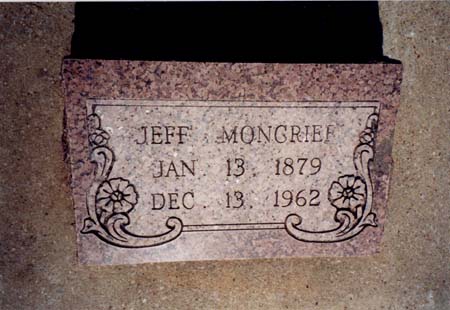
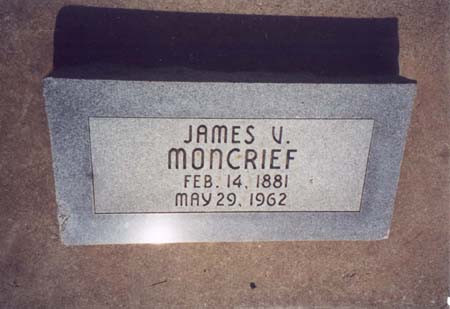
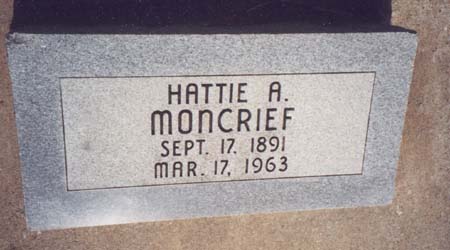
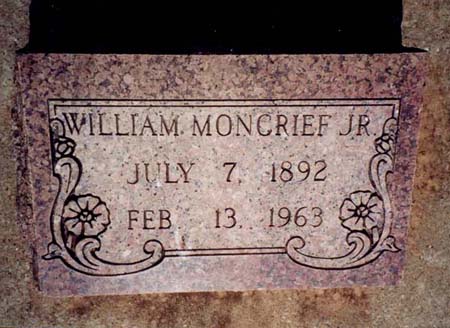
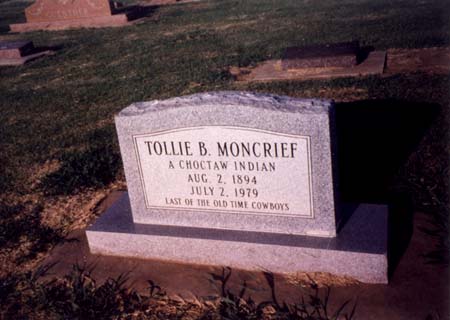
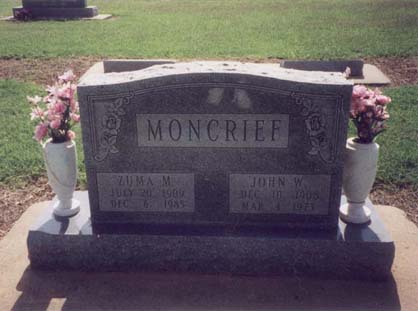
Indian Pioneer Interview October 13, 1937
MONCRIEF, BUNK INTERVIEW #8832 Field Worker's name: Thad Smith, Jr. This report made on: October 13, 1937 Name: Bunk Moncrief P. O. Address: Chickasha, Oklahoma Residence address: Route #1 Date of Birth: January 13, 1879 Place of Birth: Chickasaw-Choctaw Nation Name of Father: William Moncrief Place of Birth: Skullyville, Indian Territory Other information on father: Age 75 at death Name of Mother: Lina Maupin Place of Birth: Kentucky Other information on mother: Age 80 I was born in the Chickasaw Nation, on Roaring Creek, in 1879. My father was a farmer and trader. He raised corn to feed his cows, horses, hogs and chickens. He bought his supplies at Pauls Valley. In 1886, when I was seven years old, I went to stay with my Grandmother Moncrief, who lived on the Little Washita Rover, about three miles south of where the Fred post office was. My grandmother had one of the first herds of Durham cattle that there was in the country and her brand was M+. The country was all open, but her cattle never strayed far. My grandmother was a widow, and the cowboys were kind enough to keep a watch over her cattle, even though they never worked for her. If they would find one of her cows several miles from home, they would bring or send it back. That is one outstanding thing about the frontier men; they would all help, and respect women. Dave and Scott Cook had the post office at Fred, and they ran a general merchandise store. Mail was delivered at Fred about once a week, being carried in a stage coach or hack. From Fred the stage coach went to Anadarko, and then back on its way to Pauls Valley and Caddo. I went to school in a little one-room cottonwood box house in Fred. The benches we sat on and the tables we used for desks were made of cottonwood; the lumber used to build our school house and desks came from Bitter Creek, where there was a sawmill. There were about twenty five school children going to school at Fred and most all of them rode to school horseback. Our teacher's name was Bud Gibbs. Our school books were made by McGuffey and we used a slate instead of pencil and paper. All of the children brought their lunches, which consisted mostly of biscuits and meat. After going to school at Fred several terms I was sent to Sacred Heart, a Catholic Missionary School in the Pottawatomie county. I was treated very nice there, and they fed us good. After going to school there one term, I quit school. In 1895, when I was sixteen years old, I saddled my horse and made a trip to Texas by myself, hunting work. The people along the way whom I stayed overnight with treated me nice, fed me and my horse and never charged me anything. I got a job in Texas working on a big cattle ranch, and stayed there one year then returned to my parent's home on the north side of the Washita river just north of Chickasha. I was allotted five miles northwest of Chickasha. I am one-eighth Chickasaw. Note: Jefferson "Bump" "Bunk" Moncrief 13 Jan 1879 - 13 Dec 1962 Jeff lived in Chickasha, Grady CO, OK. He is buried in the Moncrief Family Plot at Fairlawn Cemetery, north of Chickasha, Grady CO, OK. Submitted by Sandi Carter First cousin twice removed. |
© Amarillo Sunday News-Globe Amarillo, Texas September 25, 1955 HIS GRANDCHILDREN HEAR TRUE STORIES OF COWBOYS, INDIANS James V. Moncrief Recalls Tribal History of Family By Edith B. Underwood In this day of space ships, men from Mars and other such things, it is somewhat of a relief to meet a grandfather who can entertain the `small fry' in his family with old-fashioned cowboy and Indian stories. Such tales will never grow old to the grandchildren of James V. "Jim" Moncrief, 83 Virginia. They are entirely true and the very fabric of his life because he is part Indian and grew up in Indian Territory on land allotted to members of the Choctaw tribe by the government. His story begins before the Civil war when his French grandfather, a major in the U. S. Cavalry, married a Mississippi Choctaw maiden whose name was Margaret, English version of the Indian name Mahala. When the government made a treaty with the Choctaws and began moving them to the Indian Territory, Maj. William Moncrief, his wife, a son and a daughter made the trip from Mississippi in an ox wagon. The exact date of the journey is not known but probably not before 1850 when a group of 500 or more came at one time. The trip through Southern Arkansas and up the Ouachita river was made under great hardship. They had seen floods and drought and suffered smallpox and other diseases. The miles seemed long, indeed, before they reached the land allotted to them about 40 miles from Fort Sill. The Choctaw tribe had been allotted the southern portion of the territory from the Arkansas line westward but other groups that came earlier had settled in the eastern portion. The son William, who had been born in Mississippi, was the father of Jim Moncrief. Another son, "Uncle Sam" had been born in the ox wagon en route to Indian Territory, and five other children were born after they settled there. Major Moncrief continued in the employ of the government until he was killed by the Indians in one of their raids. Grandmother Margaret lived 98 years, dying in 1913. She was buried beside her husband in the old Moncrief cemetery near Chickasha. When her husband was killed Mrs. Moncrief continued to live with her family at a place called "Old Fred." Her home was a half-way stop for government riders between Pauls Valley and Anadarko. She had a small store and post office where mail for the entire district was left twice a week. It was 70 or 80 miles on the stage route between the two places and the dispatch riders pastured their horses at her place. If a tired pony was left and the rider failed to pick it up on the return trip, a government man soon arrived to claim the U. S. property. Everything issued to the Indians, from clothing to livestock had the U. S. brand placed upon it. Being postmaster was no great chore as there was only seven or eight families in the district at that time. There was constant danger from the marauding Indians, because the Apaches and other wild tribes were still making raids on the white settlers. When the oldest son, William, grew up he became a dispatch rider for the government, carrying messages from Fort Sill to Fort Reno [now El Reno] and thence to Fort Riley, Kans. Although he could neither read nor write his wife did all the book work and he was able to carry on his duties with her help. Their home was on the old Chisholm Trail and it was there in the small community then known as Pence that James Moncrief was born, Feb. 14, 1881. Although the grandmother had been the only one with Indian blood in her family none of her children or grandchildren married Indians - the family had all of the inherited rights of the Choctaw tribe. When a white person married an Indian he could be enrolled as a member of the tribe upon the payment of $500 to the government. William Moncrief, Jr. had paid that amount to have his wife's name placed upon the Indian rolls. She was Lina Maupin, whose family had come to Indian Territory from Kentucky when she was quite small. Upon payment of $500 the person was given a roll number or headright which is his right to vote in all tribal affairs. The grandmother's number was 14,548. William Moncrief and his wife, Lina, had numbers 834 and 835. James, who was the second of their eight children, now has roll number 837. No roll numbers have been issued since 1906. Because she was enrolled as a member of the tribe, James' mother received the same allotment as his father each time one was made but she did not inherit any of his estate upon his death. The government is guardian and an Indian agent always divides the estate, which goes to the children. When Jim was a small child the family did not farm. They had some cattle and hogs which were allowed to run wild. They always had a small patch of corn which they called their "Tom Fuller" patch. Tom Fuller was their name for a favorite food which the Indians called pishofa. The corn was made into hominy and then ground into a sort of meal, which they cooked with beef or pork, preferably pork, to make pishofa. It is still cooked and served today at all Indian pow wows and Moncrief still recalls the delicious goodness of the "Tom Fuller" he ate as a child. He also remembers with less pleasure the times of terror when the Apaches of Geronimo's bunch, broke loose and went on the warpath. On one such occasion they came to the Moncrief home while his father was away. His mother had seen them on a hillside near the house and realized the impending danger to her children playing in the yard. As the band rode toward them she warned the children that they must go ahead with their play and, above all, they were not to act frightened or run from the Indians. Two of the braves separated from the band and rode on toward their home, demanding "wahaw" - Indian word for beef. Mrs. Moncrief dared not refuse and she pointed to their small herd grazing about half a mile away. They rode off and killed a calf before a band of soldiers, who were trailing them, could prevent it. They were soon taken into custody and that was the last time the Apaches escaped from the reservation. Because of his lack of education, William Moncrief wanted his children to have the advantages he had not known. James first attended Fate's Mission school near Anadarko. A Mr. and Mrs. Fate acted as superintendent and principal in this school established by the Methodist church. A Methodist preacher made periodical visits to the school and held services for the pupils. When he was about 11 James was sent to the Carlyle Indian School for boys. When he had been there about a year the children were vaccinated against smallpox and when he tells his grandchildren about the crude unsanitary way he was vaccinated, they only have to look at the scar he still bears today to realize what a painful experience that was. The arm was slashed three or four times with a penknife and the serum applied with a dirty quill. James nearly lost his arm and when the pain became unbearable he ran away from school and made his way home. Perhaps he was a little homesick but no doubt his mother's nursing helped to make things right. Later he attended a subscription school in a log cabin on the banks of the Washita river. The tuition was a dollar a month. It was during this time that he knew Quanah Parker and became friends with Quanah's daughters, Lucy and Mary. Another pleasant experience of Jim's boyhood occurred when the Rock Island built a new line which passed about 300 yards from the Moncrief home. There was no sale for eggs in those days and Jim would gather a large bucketful and take them over to the engineer on the work train. These he swapped for rides on the work engine. It was quite a treat in two ways. After riding up and down on the slow-moving engine until he got his fill the engineer would send him over to the mess camp where the cook would fill him with pie and cake. The crew had fared well on the quail and other game which was plentiful and the boy came in for his share on the egg-swapping trips. Always as a child he had watched the cattle being driven to market on the Chisholm Trail in front of their home and it was no wonder that the young boy developed a yearning for the life of a cowboy. In later years he was to make that same trip with his uncles when they would ride the train back as far as they could and then take their horses back to the ranch. His first experience was on the Waggoner spread near Lawton in old Indian Territory. Dan and Tom Waggoner had leased 2,000 acres of Indian land which was called the Big Pasture. Jim Moncrief started his life as a cowboy when he was about 16. It was while he was working on the Big Pasture that Jim came in contact with the notorious Geronimo, who had been captured in Arizona and taken to Fort Sill to spend the rest of his life in the guardhouse on the reservation. After he had apparently become reconciled to captivity, he was allowed to go about the grounds but always with heavy ball and chain shackles. When the cowboys from the Big Pasture rode in to buy tobacco and other things from the commissary at Fort Sill they often saw Geronimo. One time he saw Geronimo pick up his shackles and dart for the mess hall where he tried to get a butcher knife. Upon several occasions he nearly killed soldiers and had to be kept under heavier guard for many months. In 1900 the Waggoners lost their Big Pasture lease and it was opened up for settlers. Many people are familiar with the opening of the Cherokee strip in 1892, but the Big Pasture run in 1900 was quite real to Jim Moncrief. He saw the prospective settlers come in and camp for two months before the day of the run. Many of them lived off the Indians and white people nearby, killing their cattle and taking other things to meet their daily needs after they had used their own supplies. Back in 1896, Jim had made a trip to Texas and New Mexico with an uncle and he liked what he had seen well enough to strike out on his own in 1901. His experience with the Waggoners had been a happy one and he went next to XIT where he worked about a year and a half. His entire time with them was spent in the Yellowhouse Canyon division. He had done some bronc busting but he began to get more experience there. When a cowboy went to a ranch and hired out, he rode his own horse but he never rode it again as long as he worked there unless he just wanted to. It was turned loose on the range until he chose to ride it again. The first day the boss took his new cowpuncher to the corral he picked out seven horses - one for each day of the week. These he had to break himself and it didn't take the boss long to find out the sort of man he had hired. Twenty-five dollars a month was top wages at that time. When he was about 21, Jim went to the LFD Cattle Co. at Roswell, N. M. and hired out to George and Bill Littlefield. It was while he was working for them that he had the one serious accident of his life. He had been thrown, kicked, runover and knocked down many times but in roping a bull he had his horse jerked from under him. The horse fell on him and before the other men could cut the bull loose and get the horse off him, Jim was bruised and lacerated. Not knowing the extent of his injuries, Bill Littlefield put him in the buckboard and started on the journey to the hospital in El Paso. They left the LFD headquarters near Roswell late one afternoon and drove all night by way of Carlsbad to Van Horn, arriving there about noon the following day. There they took the train to El Paso and Jim spent 30 days in the hospital. Littlefield had stayed only long enough to see that his cowboy was not going to die and returned on the next train. Once or twice a year Jim would saddle his horse and make the trip back to Indian Territory for a visit with his family. In 1906 he made such a trip and on that visit he was to meet a girl who had moved into the community since his last visit. Perhaps the girl had something to do with it but after another visit in 1907 he decided to give up broncbusting and cowpunching to marry Hattie Nunn. Hattie had lived through some exciting experiences during the 16 years before her marriage. She had been born in Kentucky and upon the death of her father, when she was nearly 8, her mother took her three children to Decator to make her home near her father-in-law. The family lived there for several years until her mother remarried. The stepfather took them to Potawatomi County in the eastern part of what was soon to be Oklahoma. In 1905 the family moved to the community near Chickasha. This trip was made in a covered wagon and Mrs. Moncrief recalls many of the dangers of the trip. Near Purcell they had to ford the Canadian river, where guides were stationed to lead the wagons across the dangerous quicksand. Their fee was $5 for each wagon and the stepfather was determined not to pay that much. He watched as other wagons were guided across and thought he could follow in their tracks. The Canadian is a treacherous river and it wasn't long before the horses floundered and for awhile it looked as though all would be lost. The guides rescued the family by horseback from the wagon and then roped the horses to pull them and the wagon to safety. Their best horse died soon after from the experience. Soon after their marriage, Jim bought a claim near Ima, N. M., and the young couple made the trip out there in a covered wagon in the summer of 1908. The altitude proved too high for Mrs. Moncrief and in October the doctor ordered her to return to Chickasha. After accompanying his wife to her mother's home, Jim returned to the place in New Mexico and stayed until January of 1909. Their oldest son, John was born during his absence and another son, LeRoy "Buster", also was born at Chickasha. The family moved over to Wapanucka in 1912 to stay three years but both sons started to school and graduated in Chickasha. Both married there. John, who has a son and daughter, still lives there, although he lived in Amarillo for a number of years during the war. L. R., who has two sons, lives at 205 N. Belleview. Since 1943, the Moncriefs have lived in Amarillo where he was employed by the city and later at the Amarillo Country Club for four years. As long as his health would permit he enjoyed the outdoor work but in recent years the care of his lawn and garden and the raising of prize dahlias has occupied his time. There are always old friends to visit with and talk of days upon the trail and nights around the campfire and times when a man might be called up before a tribal court, but wasn't. Although the Indians are governed by the white man's laws now there was a time when an Indian trial was enough to make a cowpuncher keep on the straight and narrow trail. Life for Jim Moncrief will still be pleasant as long as there are little boys to sit in openmouthed wonder while grandfather tells another yarn about cowboys and Indians. Note: James Valentine "Jim" Moncrief 14 Feb 1879 ~ 13 Dec 1962 He lived in Amarillo, Texas as the time of his death. He is buried at Fairlawn Cemetery north of Chickasha, Grady CO, OK Submitted by Sandi Carter First cousin twice removed of James V. Moncrief |
May 1963 September 17, 1891 ~ March 17, 1963 Mrs. Hattie Nunn Moncrief, 73, of 307 South Fifth, Chickasha, Oklahoma, died Sunday morning, 17 March 1963. She was born 17 September 1891 in Kentucky and came to Chickasha in 1905. She met and married James Valentine "Jim" Moncrief in 26 October 1907. He died 29 May 1962 and is buried at Fairlawn Cemetery in the Moncrief family plot. They moved to Amarillo, Texas in 1942 and lived there until 1959, when they came back to Chickasha. Mrs. Moncrief was a member of the Baptist Church. Survivors include two sons, John William Moncrief, Oklahoma City, and Le Roy "Buster" Moncried, Amarillo, Texas, one sister, Mrs. Hazel Raddlesburger, Amarillo, two brothers, Tyler Nunn, Lincoln, Nebraska and Lonnie Hardin, Tulsa, Oklahoma, four grandchildren and four great grandchildren. Funeral services will be held at 3:30 p.m., Tuesday, 19 March 1963, in the chapel of Brown's Funeral Home. Dr. Jerold McBride, pastor of the First Baptist Church, will officiate. Interment will be in the Moncrief family plot at Fairlawn Cemetery. |
© The Chickasha Express-Star Chickasha, Oklahoma March 6, 1975 December 10, 1908 ~ March 4, 1975 Funeral services for John W. Moncrief, Route 1, Fort Cobb, were held at 11 a.m. Friday, March 7 in the chapel of the Brown Funeral Home. Mr. Moncrief was born December 10, 1908 in Chickasha. He died on Tuesday, March 4, in the Anadarko Hospital. He married his wife, Zuma Mary Sitterding, October 29, 1932, in Chickasha. He worked as manager at Melton Tractor and Supply for 14 years. For the past ten years he worked with Central Oklahoma Equipment Co. in Oklahoma City. He was a member of the Rancho Village Baptist Church of Oklahoma City and was a 32nd degree Mason, being a member of the Chickasha Masonic Lodge No. 94. Survivors include his wife, Zuma, of the home; one daughter, Mrs. [Kay Johnna] Jerry Strange of Baltimore, Md.; one son, James Robert Moncrief of Oklahoma City; one brother, Le Roy "Buster" Moncrief of Amarillo, Texas; and one grandson and four granddaughters. Interment was in the Fairlawn Cemetry under the direction of the Brown Funeral Home. |
This site may be freely linked, but not duplicated in any way without consent.
All rights reserved! Commercial use of material within this site is prohibited!
© 2000-2024 Oklahoma CemeteriesThe information on this site is provided free for the purpose of researching your genealogy. This material may be freely used by non-commercial entities, for your own research, as long as this message remains on all copied material. The information contained in this site may not be copied to any other site without written "snail-mail" permission. If you wish to have a copy of a donor's material, you must have their permission. All information found on these pages is under copyright of Oklahoma Cemeteries. This is to protect any and all information donated. The original submitter or source of the information will retain their copyright. Unless otherwise stated, any donated material is given to Oklahoma Cemeteries to make it available online. This material will always be available at no cost, it will always remain free to the researcher.